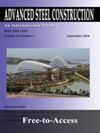横向支撑非弹性压缩构件的性能与设计
IF 1.7
3区 工程技术
Q3 CONSTRUCTION & BUILDING TECHNOLOGY
引用次数: 1
摘要
收稿日期:2007年7月23日;修订日期:2007年10月5日;摘要:本文研究了均布压缩条件下几何缺陷侧撑柱的非弹性响应。本研究采用非弹性分析中的伪荷载方法,对构件从加载开始到最终破坏的荷载挠曲行为进行跟踪。待分析的压缩构件在两端被钉住,并在某个中间点由支撑支撑。支撑被建模为一个弹簧,它的位置可以在压缩构件的长度内变化。虽然这个弹簧支撑被认为是弹性的,但被支撑的压缩构件可能会经历非弹性。研究了支撑受压构件的非弹性性能、侧撑要求以及支撑位置对支撑构件极限强度的影响。与通常的设计实践相反,假设支撑点是刚性的,没有横向运动,研究表明,这种所谓的完全支撑条件很少实现。因此,压缩构件的实际强度将低于其代码规定的值。为了确保安全设计,必须适当考虑支撑的合理设计。提出了支撑构件至少达到规范规定的设计抗压强度90%所需的支撑刚度和强度的设计方程。本文章由计算机程序翻译,如有差异,请以英文原文为准。
Behavior and design of laterally braced inelastic compression members
Received: 23 July 2007; Revised: 5 October 2007; Accepted: 10 October 2007 ABSTRACT: This paper presents a numerical study of the inelastic response of laterally braced geometrically imperfect columns under uniform compression. The study employs the pseudo load method of inelastic analysis in which the load deflection behavior of the member is traced from the beginning of loading to ultimate failure. The compression member to be analyzed is pinned at both ends and is supported at some intermediate point by a brace. The brace is modeled as a spring and its location can vary within the length of the compression member. Although this spring brace is assumed to behave in an elastic fashion, the compression member being braced can experience inelasticity. The inelastic behavior of this braced compression member as well as the lateral bracing requirements and the effect of brace location on the ultimate strength of the braced member are investigated. Contrary to the usual design practice in which the braced point is assumed to be rigid and undergo no lateral movement, studies have shown that such a so-called fully-braced condition is rarely realized. As a result, the actual strength of the compression member will fall below its code-specified value. To ensure a safe design, due considerations must be given to the proper design of the brace. Design equations for the stiffness and strength of a brace required to develop at least 90% of this code-specified design compressive strength for the braced member are proposed.
求助全文
通过发布文献求助,成功后即可免费获取论文全文。
去求助
来源期刊

Advanced Steel Construction
CONSTRUCTION & BUILDING TECHNOLOGY-ENGINEERING, CIVIL
CiteScore
2.60
自引率
29.40%
发文量
0
审稿时长
6 months
期刊介绍:
The International Journal of Advanced Steel Construction provides a platform for the publication and rapid dissemination of original and up-to-date research and technological developments in steel construction, design and analysis. Scope of research papers published in this journal includes but is not limited to theoretical and experimental research on elements, assemblages, systems, material, design philosophy and codification, standards, fabrication, projects of innovative nature and computer techniques. The journal is specifically tailored to channel the exchange of technological know-how between researchers and practitioners. Contributions from all aspects related to the recent developments of advanced steel construction are welcome.
 求助内容:
求助内容: 应助结果提醒方式:
应助结果提醒方式:


